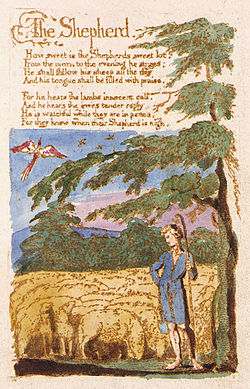
"The Chimney Sweeper" is the title of a poem by William Blake, published in two parts in Songs of Innocence in 1789 and Songs of Experience in 1794. The poem "The Chimney Sweeper" is set against the dark background of child labour that was prominent in England in the late 18th and 19th centuries. At the age of four and five, boys were sold to clean chimneys, due to their small size. These children were oppressed and had a diminutive existence that was socially accepted at the time. Children in this field of work were often unfed and poorly clothed. In most cases, these children died from either falling through the chimneys or from lung damage and other horrible diseases from breathing in the soot. In the earlier poem, a young chimney sweeper recounts a dream by one of his fellows, in which an angel rescues the boys from coffins and takes them to a sunny meadow; in the later poem, an apparently adult speaker encounters a child chimney sweeper abandoned in the snow while his parents are at church or possibly even suffered death where church is referring to being with God.

"The Echoing Green" is a poem by William Blake published in Songs of Innocence in 1789. The poem talks about merry sounds and images which accompany the children playing outdoors. Then, an old man happily remembers when he enjoyed playing with his friends during his own childhood. The last stanza depicts the little ones being weary when the sun has descended and going to their mother to rest after playing many games.

"The Little Black Boy" is a poem by William Blake included in Songs of Innocence in 1789. It was published during a time when slavery was still legal and the campaign for the abolition of slavery was still young.
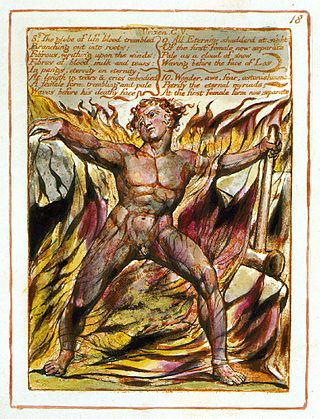
In the mythological writings of William Blake, Los is the fallen form of Urthona, one of the four Zoas, and the embodiment of human creativity and inspiration. He is referred to as the "eternal prophet" and creates the visionary city of Golgonooza. Los is regularly described as a smith, beating with his hammer on a forge, which is metaphorically connected to the beating of the human heart. The bellows of his forge are the human lungs. Los's emanation, Enitharmon, represents spiritual beauty and embodies pity, but at the same time creates the spatial aspect of the fallen world, weaving bodies for men and creating sexual strife through her insistence upon chastity. In the Book of Urizen (1794), Los and Enitharmon have a child, Orc, who is the embodiment of the spirit of revolution. The name Los is, by common critical acceptance, an anagram of Sol, the Latin word for "sun". Los is also the plural form of El, an ancient Hebrew deity. Such innovations are common in many of Blake's prophetic poems.

A shepherd's crook is a long and sturdy stick with a hook at one end, often with the point flared outwards, used by a shepherd to manage and sometimes catch sheep. In addition, the crook may aid in defending against attack by predators. When traversing rough terrain, a crook is an aid to balance. Shepherds may also use the long implement to part thick undergrowth when searching for lost sheep or potential predators.
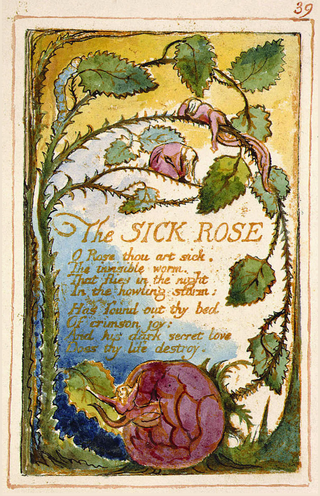
"The Sick Rose" is a poem by William Blake, originally published in Songs of Innocence and of Experience as the 39th plate; the incipit of the poem is O Rose thou art sick. Blake composed the poem sometime after 1789, and presented it with an illuminated border and illustration, typical of his self-publications. Since the 20th century, the poem has been the subject of scrutiny by scholars for its oblique and enigmatic meaning, and bizarre, suggestive imagery.

Holy Thursday is a poem by William Blake, from his 1789 book of poems Songs of Innocence.

"Holy Thursday" is a poem by William Blake, first published in Songs of Innocence and Experience in 1794. This poem, unlike its companion poem in "Songs of Innocence" (1789), focuses more on society as a whole than on the ceremony held in London.

Earth's Answer is a poem by William Blake within his larger collection called Songs of Innocence and of Experience. It is the response to the previous poem in The Songs of Experience-- Introduction . In the Introduction, the bard asks the Earth to wake up and claim ownership. In this poem, the feminine Earth responds.

The Little Girl Lost is a 1794 poem published by William Blake in his collection Songs of Innocence and of Experience. According to scholar, Grevel Lindop, this poem represents Blake's pattern of the transition between "the spontaneous, imaginative Innocence of childhood" to the "complex and mature adult state of Experience."

"The Lilly" is a poem written by the English poet William Blake. It was published as part of his collection Songs of Experience in 1794.
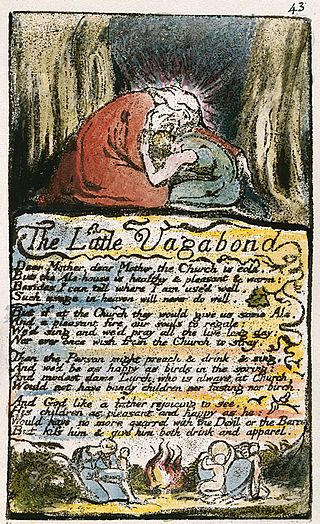
The Little Vagabond is a 1794 poem by English poet William Blake in his collection Songs of Innocence and of Experience. His collection, Songs of Innocence, was originally published alone, in 1789. The scholar Robert Gleckner says that the poem is a form of transformation of the boy in the poem "The School Boy", from Songs of Innocence.

"Infant Joy" is a poem written by the English poet William Blake. It was first published as part of his collection Songs of Innocence in 1789 and is the counterpart to "Infant Sorrow", which was published at a later date in Songs of Experience in 1794.
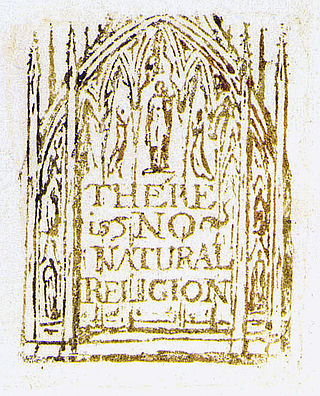
There is No Natural Religion is a series of philosophical aphorisms by William Blake, written in 1788. Following on from his initial experiments with relief etching in the non-textual The Approach of Doom (1787), All Religions are One and There is No Natural Religion represent Blake's first successful attempt to combine image and text via relief etching, and are thus the earliest of his illuminated manuscripts. As such, they serve as a significant milestone in Blake's career; as Peter Ackroyd points out, "his newly invented form now changed the nature of his expression. It had enlarged his range; with relief etching, the words inscribed like those of God upon the tables of law, Blake could acquire a new role."
"Night" is a poem in the illuminated 1789 collection Songs of Innocence by William Blake, later incorporated into the larger compilation Songs of Innocence and of Experience. "Night" speaks about the coming of evil when darkness arrives, as angels protect and keep the sheep from the impending dangers.

"The Little Boy Found" is a poem by William Blake first published in the collection Songs of Innocence in 1789. Songs of Innocence was printed using illuminated printing, a style Blake created. By integrating the images with the poems the reader was better able to understand the meaning behind each of Blake's poems.

"The Little Boy Lost" is a simple lyric poem written by William Blake. This poem is part of a larger work titled Songs of Innocence which was published in the year 1789. "The Little Boy Lost" is a prelude to "The Little Boy Found".
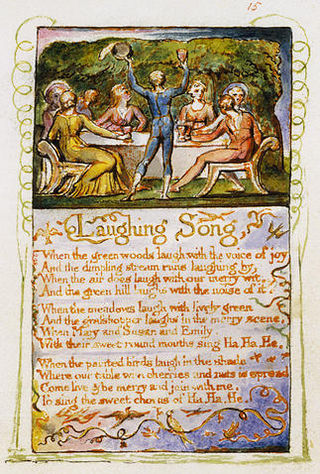
"Laughing Song" is a poem published in 1789 by the English poet William Blake. This poem is one of nineteen in Blake's collection Songs of Innocence.

"The School Boy" is a 1789 poem by William Blake and published as a part of his poetry collection entitled Songs of Experience. These poems were later added with Blake's Songs of Innocence to create the entire collection entitled "Songs of Innocence and of Experience Shewing the Two Contrary States of the Human Soul". This collection included poems such as "The Tyger", "The Little Boy Lost", "Infant Joy" and "The Shepherd". These poems are illustrated with colorful artwork created by Blake first in 1789. The first printing in 1789 consisted of sixteen copies. None of the copies of Songs of Innocence are exactly alike as some of them are incomplete or were colored in posthumously "in imitation of" other copies.
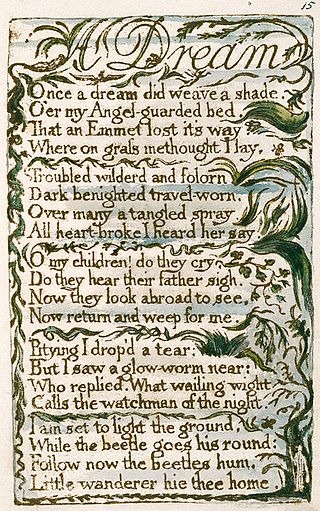
"A Dream" is a poem by English poet William Blake. The poem was first published in 1789 as part of Blake's collection of poems entitled Songs of Innocence.
